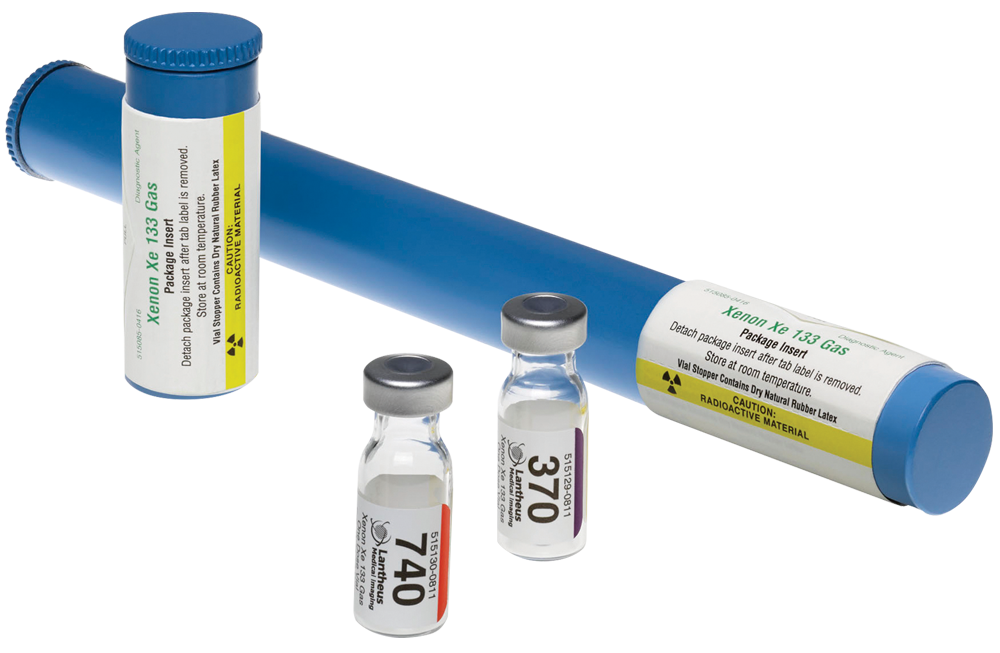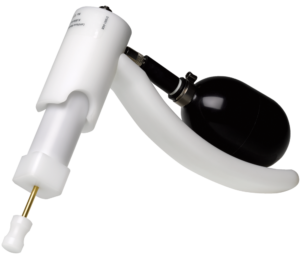About
 Xenon-133 is an inhaled radiopharmaceutical imaging agent primarily used to image the lungs and evaluate pulmonary function. It may also be used to assess cerebral blood flow.
Xenon-133 is an inhaled radiopharmaceutical imaging agent primarily used to image the lungs and evaluate pulmonary function. It may also be used to assess cerebral blood flow.
Xenon-133 Gas is inhaled to provide diagnostically relevant images of the lungs to physicians. According to Parker et al., Xenon-133 offers “a more complete characterization of ventilation and a more sensitive test for obstructive airway disease.”1
 Lantheus is a leading U.S. manufacturer of Xenon-133. Lantheus’ Calidose® Dispenser System is specifically designed and approved by the U.S. Food and Drug Administration (FDA) for use with Lantheus Xenon-133 vials.
Lantheus is a leading U.S. manufacturer of Xenon-133. Lantheus’ Calidose® Dispenser System is specifically designed and approved by the U.S. Food and Drug Administration (FDA) for use with Lantheus Xenon-133 vials.
IMPORTANT SAFETY INFORMATION
INDICATIONS AND USAGE
Inhalation of Xenon Xe-133 Gas has proved valuable for the evaluation of pulmonary function and for imaging the lungs. It may also be applied to assessment of cerebral flow.
CONTRAINDICATIONS
None known.
IMPORTANT SAFETY INFORMATION
Adverse reactions related to the use of this agent have not been reported to date.
WARNINGS
Xenon Xe-133 Gas delivery systems, i.e., respirators or spirometers, and associated tubing assemblies must be leak-proof to avoid loss of radioactivity into environs not specifically protected by exhaust systems.
Xenon Xe-133 adheres to some plastics and rubber and should not be allowed in tubing or respirator containers. The unrecognized loss of radioactivity from the dose for administration may render the study non-diagnostic.
The vial stopper contains dry natural rubber latex and may cause allergic reactions in providers or patients who are sensitive to latex.
PRECAUTIONS
General
Xenon Xe-133, as well as other radioactive drugs, must be handled with care and appropriate safety measures should be used to minimize radiation exposure to patients and to clinical personnel.
Radiopharmaceuticals should be used only by physicians who are qualified by training and experience in the safe use and handling of radionuclides and whose experience and training have been approved by the appropriate government agency authorized to license the use of radionuclides.
Please see full Prescribing Information.
References: 1. Parker et al., SNMMI Practice Guideline for Lung Scintigraphy 4.0, Journal of Nuclear Medicine Technology, 2012; Vol 40: No 1: 57-65 http://snmmi.files.cms-plus.com/ACNM/Documents/Lung_Scintigraphy_V4_Final.pdf.
 |
This site is intended for U.S. Healthcare Professionals only. PM-US-CA-0018-V2 October 2024 |
